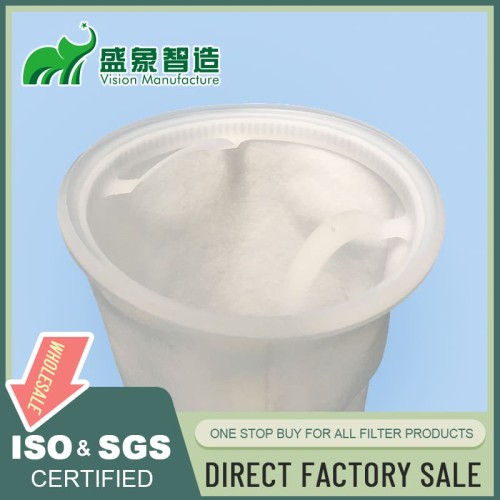
Mastering Liquid Filtration: A Comprehensive Micron Filter Bag Chart Guide
I. Introduction
In the intricate world of liquid processing, the precision of filtration can significantly impact product quality, process efficiency, and operational costs. Filter bags, integral to this process, are selected based on micron ratings, which determine their ability to remove contaminants of specific sizes from liquids. Understanding these ratings is crucial for ensuring efficient filtration and maintaining the integrity of industrial processes. This guide delves into the importance of micron ratings and introduces Vision Filter's approach to leveraging these specifications for optimal filtration performance.
II. Understanding Micron Ratings
A micron is a unit of measurement equivalent to one millionth of a meter, used to describe the size of particles that filter media can capture. Micron ratings in filter bags indicate the size of the smallest particle that the bag can filter out of a liquid. These ratings can be nominal or absolute, with nominal ratings capturing a percentage of particles at the specified size, and absolute ratings capturing nearly all particles at that size. This distinction is critical for applications requiring high precision in particle removal.
III. The Full Micron Filter Bag Chart
Vision Filter provides a detailed micron filter bag chart that categorizes bags from 1 to 1500 microns. This chart is essential for users to select the appropriate filter bag based on specific filtration needs:
- 1-5 Microns: Used for ultra-fine filtration in applications like pharmaceuticals and electronics.
- 10-25 Microns: Suitable for fine filtration in food and beverage production.
- 50-100 Microns: Applied in medium filtration scenarios such as automotive coatings.
- 150-800 Microns: Used for coarse filtration in applications like wastewater treatment.
- 1000-1500 Microns: Ideal for very coarse filtration tasks such as pre-filtering before finer stages.
IV. Micron Ratings and Their Applications
Different industries require specific micron ratings to achieve desired filtration outcomes:
- Ultra-fine Filtration (1-5 microns): Critical for removing minute impurities in high-precision industries.
- Fine Filtration (10-25 microns): Targets finer particulates for clearer, purer outputs in food and beverages.
- Medium Filtration (50-100 microns): Balances efficiency and flow rate in various manufacturing processes.
- Coarse Filtration (150-800 microns): Handles larger particles, protecting downstream equipment from clogging and damage.
- Very Coarse Filtration (1000-1500 microns): Typically used as a preliminary stage to protect finer filters from large debris.
V. Filter Bag Materials and Their Micron Ratings
The effectiveness of a micron rating also depends on the material of the filter bag:
- Polyester and Polypropylene: Popular for their versatility and range of micron ratings.
- Nylon: Known for its strength and elasticity, suitable for finer micron ratings.
- PTFE (Teflon): Offers chemical resistance and is used in harsh chemical environments.
- Multifilament and Monofilament Mesh: Provide precise ratings and are used for their specific weave patterns.
VI. Factors Influencing Micron Rating Selection
Selecting the right micron rating involves considering:
- Particle Size Distribution: Understanding the range of particle sizes present in the liquid.
- Flow Rate Requirements: Higher flow rates may require larger micron ratings to prevent pressure drops.
- Pressure Drop Considerations: Ensuring the filter bag can handle the system’s pressure without bursting.
- Desired Filtration Efficiency: Achieving the balance between particle removal efficiency and operational cost.
VII. Understanding Filter Efficiency and Beta Ratios
Filter efficiency is often expressed through beta ratios, which quantify how well a filter can remove particles of a specific size. A higher beta ratio indicates better filtration performance. Understanding these ratios helps in selecting the right filter bag for achieving optimal efficiency.
VIII. Multi-Stage Filtration Using Different Micron Ratings
Multi-stage filtration involves using several filter bags with decreasing micron ratings in sequence. This approach enhances overall filtration efficiency, extends filter life, and can be tailored to meet specific regulatory requirements. Vision Filter offers solutions that integrate multi-stage systems effectively.
IX. Maintenance and Monitoring of Filter Bags
Regular maintenance is crucial for sustaining filtration performance:
- Inspections: Routine checks for wear and tear.
- Cleaning: Proper cleaning techniques to restore filtration capacity.
- Replacement: Timely replacement of bags to prevent failures and maintain efficiency.
X. Innovations in Micron-Rated Filter Bag Technology
Vision Filter is at the forefront of developing advanced materials and technologies in filter bags:
- Hybrid Media: Combining different materials to enhance filtration properties.
- Smart Monitoring Systems: Technologies that allow real-time tracking of filter performance.
XI. Case Studies: Micron Ratings in Action
Real-world examples illustrate how selecting the appropriate micron ratings can solve complex filtration challenges, showcasing Vision Filter’s expertise in providing tailored solutions that enhance both efficiency and cost-effectiveness in industrial settings.
XII. Future Trends in Liquid Filtration Technology
The future of liquid filtration is poised for significant advancements with the development of finer micron-rated materials and the integration of smart technologies. These innovations promise to deliver even greater precision and efficiency in industrial filtration processes.
XIII. Conclusion
Understanding and utilizing the full micron filter bag chart is essential for mastering liquid filtration. With advanced materials and expert guidance from Vision Filter, industries can optimize their filtration systems to meet both current and future challenges. Engage with our team to explore how our cutting-edge solutions can enhance your operations and ensure compliance with the highest standards of quality and efficiency.
Leave a comment

